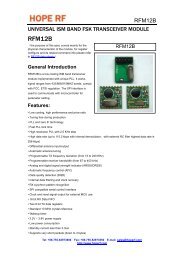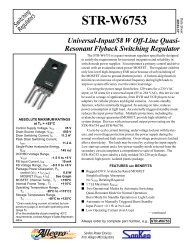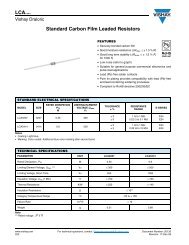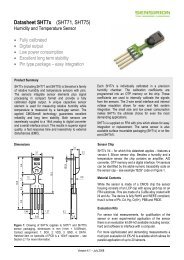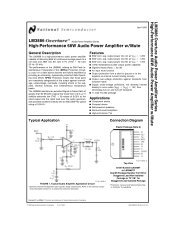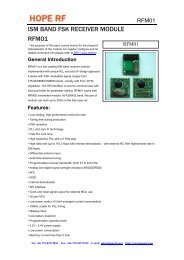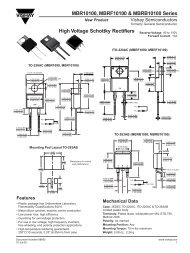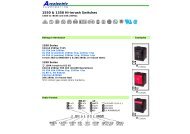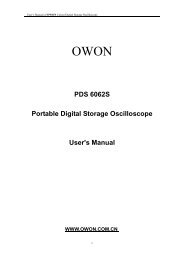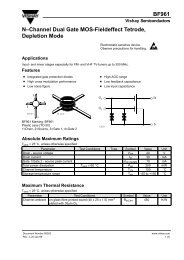FSDM07652RB Green Mode Fairchild Power Switch ... - HEStore.hu
FSDM07652RB Green Mode Fairchild Power Switch ... - HEStore.hu
FSDM07652RB Green Mode Fairchild Power Switch ... - HEStore.hu
You also want an ePaper? Increase the reach of your titles
YUMPU automatically turns print PDFs into web optimized ePapers that Google loves.
<strong>FSDM07652RB</strong><br />
Vds<br />
<strong>Power</strong><br />
on<br />
Fault<br />
occurs<br />
Fault<br />
removed<br />
V FB<br />
6.0V<br />
Over load protection<br />
2.5V<br />
Vcc<br />
T 12<br />
12<br />
= Cfb*(6.0-2.5)/I delay<br />
delay<br />
12V<br />
8V<br />
T 1<br />
T 2<br />
Figure 7. Over load protection<br />
t<br />
Normal<br />
operation<br />
Fault<br />
situation<br />
Figure 6. Auto restart operation<br />
Normal<br />
operation<br />
3.1 Over Load Protection (OLP) : Overload is defined as<br />
the load current exceeding a pre-set level due to an<br />
unexpected event. In this situation, the protection circuit<br />
should be activated in order to protect the SMPS. However,<br />
even when the SMPS is in the normal operation, the over<br />
load protection circuit can be activated during the load<br />
transition. In order to avoid this undesired operation, the over<br />
load protection circuit is designed to be activated after a<br />
specified time to determine whether it is a transient situation<br />
or an overload situation. Because of the pulse-by-pulse<br />
current limit capability, the maximum peak current through<br />
the Sense FET is limited, and therefore the maximum input<br />
power is restricted with a given input voltage. If the output<br />
consumes beyond this maximum power, the output voltage<br />
(Vo) decreases below the set voltage. This reduces the<br />
current through the opto-coupler LED, which also reduces<br />
the opto-coupler transistor current, t<strong>hu</strong>s increasing the<br />
feedback voltage (Vfb). If Vfb exceeds 2.5V, D1 is blocked<br />
and the 3.5uA current source starts to charge CB slowly up to<br />
Vcc. In this condition, Vfb continues increasing until it<br />
reaches 6V, when the switching operation is terminated as<br />
shown in Figure 7. The delay time for s<strong>hu</strong>tdown is the time<br />
required to charge CB from 2.5V to 6.0V with 3.5uA. In<br />
general, a 10 ~ 50 ms delay time is typical for most<br />
applications.<br />
t<br />
3.2 Over voltage Protection (OVP) : If the secondary side<br />
feedback circuit were to malfunction or a solder defect<br />
caused an open in the feedback path, the current through the<br />
opto-coupler transistor becomes almost zero. Then, Vfb<br />
climbs up in a similar manner to the over load situation,<br />
forcing the preset maximum current to be supplied to the<br />
SMPS until the over load protection is activated. Because<br />
more energy than required is provided to the output, the<br />
output voltage may exceed the rated voltage before the over<br />
load protection is activated, resulting in the breakdown of the<br />
devices in the secondary side. In order to prevent this<br />
situation, an over voltage protection (OVP) circuit is<br />
employed. In general, Vcc is proportional to the output<br />
voltage and the <strong>FSDM07652RB</strong> uses Vcc instead of directly<br />
monitoring the output voltage. If VCC exceeds 19V, an OVP<br />
circuit is activated resulting in the termination of the<br />
switching operation. In order to avoid undesired activation of<br />
OVP during normal operation, Vcc should be designed to be<br />
below 19V.<br />
3.3 Thermal S<strong>hu</strong>tdown (TSD) : The Sense FET and the<br />
control IC are built in one package. This makes it easy for<br />
the control IC to detect the heat generation from the Sense<br />
FET. When the temperature exceeds approximately 150°C,<br />
the thermal s<strong>hu</strong>tdown is activated.<br />
4. Soft Start : The <strong>FSDM07652RB</strong> has an internal soft start<br />
circuit that increases PWM comparator inverting input<br />
voltage together with the Sense FET current slowly after it<br />
starts up. The typical soft start time is 10msec, The pulse<br />
width to the power switching device is progressively<br />
increased to establish the correct working conditions for<br />
transformers, inductors, and capacitors. The voltage on the<br />
output capacitors is progressively increased with the<br />
intention of smoothly establishing the required output<br />
voltage. It also helps to prevent transformer saturation and<br />
reduce the stress on the secondary diode during startup.<br />
12



